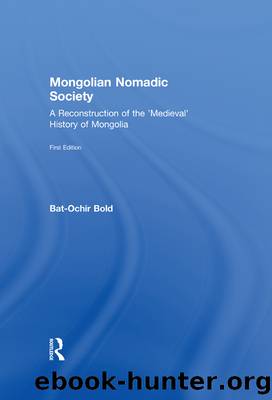Mongolian Nomadic Society by Bat-Ochir Bold

Author:Bat-Ochir Bold [Bold, Bat-Ochir]
Language: eng
Format: epub, pdf
Tags: Social Science, Ethnic Studies, General, Regional Studies
ISBN: 9781136824807
Google: vVdUAQAAQBAJ
Publisher: Routledge
Published: 2013-10-11T04:51:51+00:00
After the conference of Dolonur in 1691,9 otog kept its earlier meaning only in connection with the shavi10 of rJe-bcun dam-pa,11 and from the middle of the eighteenth century it was no longer frequently used. The reason for this lay in the Manchurian administration policy in Mongolia.
Khoshuu
Khoshuu is another term for an administrative unit that stands in close relation to aimag and otog. It is also unclear exactly when this term first came to be used. According to W. Barthold, it originally meant a military unit of 1,000 warriors in Cagadai Ulus (Barthold 1966: vol. 2, sect. 2: 50). The leader of this unit was called khoshuuchi.
After the period of Batumünkhe Dayan Khaan one frequently encounters the expressions âKhalkha seven Otogâ and âKhalkha seven Khoshuuâ, in the sources used in conjunction with each other. There are further reports about successful warriors being distinguished with the rank of khoshuuchi and darkhan by Batumünkhe Dayan Khaan. But it should not be believed that a khoshuuchi stood at the head of a khoshuu or otog or that he governed (Nacagdorj 1978: 152). He was merely the leader of the warriors from a khoshuu or otog, as research investigations have concluded.
Some researchers assume that the expression khoshuu was used in connection with military affairs while otog was used more for civil matters. Gradually khoshuu came to designate the largest administrative-territorial units, until the aimag became the largest unit. It could well be maintained that in this period a khoshuu represented a unit that was politically and administratively quite independent and which comprised a large territory and a large population. For this reason khoshuu remained relatively stable for some time. D. Cedev writes that the structure of the seven khoshuus existed until the middle of the seventeenth century (Cedev 1964: 24). After the formation of the aimag units, however, the khoshuu units lost some of their significance.
After the conquest of Mongolia by the Manchu and the subsequent introduction of the Manchu-Chinese banner system, the word khoshuu was once again used as an administrative unit. However, the Manchu used the word to refer to a banner located within an aimag, which, in comparison with earlier khoshuus, comprised neither a large territory nor a large population.
Chuulgan
A moment of political significance for the Mongolian state system was the conferences of this period known as chuulgan. After about the middle of the sixteenth century until the seventeenth century, the use of the word chuulgan increased. This conference form was no doubt an extension of khurildai, which we have already discussed. Since the sixteenth century was characterised by a turn towards decentralisation, the sovereignty of the Great Khaan decreased and the rights of other princes increased. Chuulgan could well be a reflection of this shift of power.
The sources contain reports about all the chuulgans of 40 groups of ten thousand and four groups of ten thousand and about 18 conferences of the Great chuulgan of princes from âKhalkha seven khoshuuâ (Mongol ba töv ⦠1974: 6). We have however no concrete references concerning the structuring of the conferences.
Download
This site does not store any files on its server. We only index and link to content provided by other sites. Please contact the content providers to delete copyright contents if any and email us, we'll remove relevant links or contents immediately.
Verus Israel: Study of the Relations Between Christians and Jews in the Roman Empire, AD 135-425 by Marcel Simon(569)
Phoenicians among Others: Why Migrants Mattered in the Ancient Mediterranean by Denise Demetriou(568)
Caesar Rules: The Emperor in the Changing Roman World (c. 50 BC â AD 565) by Olivier Hekster(551)
Europe, Strategy and Armed Forces by Sven Biscop Jo Coelmont(495)
Give Me Liberty, Seventh Edition by Foner Eric & DuVal Kathleen & McGirr Lisa(464)
Banned in the U.S.A. : A Reference Guide to Book Censorship in Schools and Public Libraries by Herbert N. Foerstel(462)
american english file 1 student book 3rd edition by Unknown(455)
Reading Colonial Japan by Mason Michele;Lee Helen;(453)
The Roman World 44 BC-AD 180 by Martin Goodman(452)
DS001-THE MAN OF BRONZE by J.R.A(437)
The Dangerous Life and Ideas of Diogenes the Cynic by Jean-Manuel Roubineau(429)
The Oxford History of World War II by Richard Overy(427)
Basic japanese A grammar and workbook by Unknown(427)
Imperial Rome AD 193 - 284 by Ando Clifford(426)
Introducing Christian Ethics by Samuel Wells and Ben Quash with Rebekah Eklund(426)
Literary Mathematics by Michael Gavin;(385)
Language Hacking Mandarin by Benny Lewis & Dr. Licheng Gu(366)
How to Reach the 9.0 in IELTS Academic Reading by IELTS Medical(350)
The Oxford History of the Renaissance by Campbell Gordon;(343)
